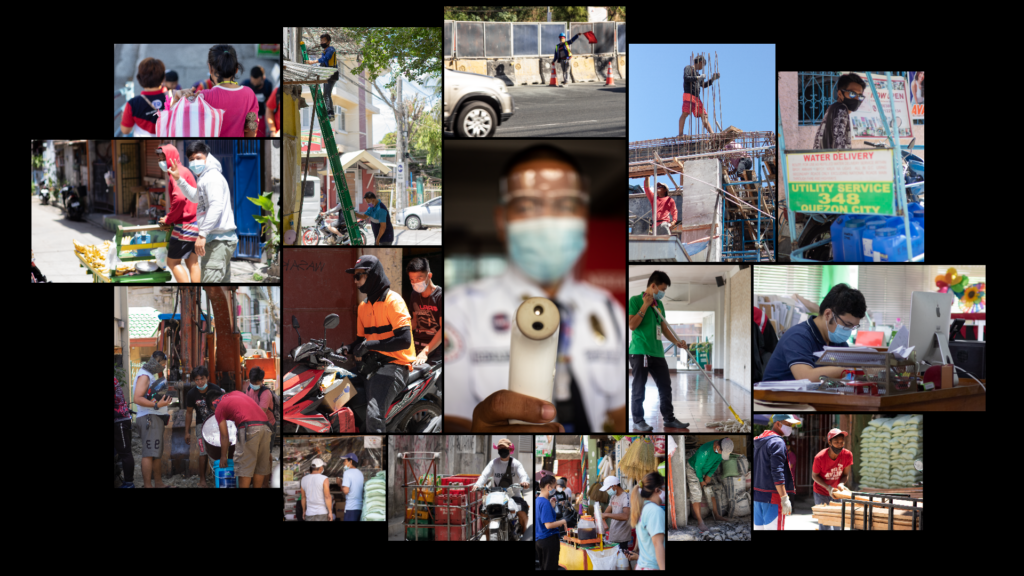(The original article is posted on Prof. Batongbacal’s Facebook page, linked at the bottom. His three-part post is collated here in full.) Speaker Macapagal-Arroyo’s September Surprise of a charter-change proposal certainly raised eyebrows, but it was not until the inflation and rice issues blew over somewhat that proper consideration was directed toward the unexpected constitutional initiative. Attention immediately zeroed in on the incredibly brazen attempt to exclude the current duly-elected Vice President from the line of succession to the Presidency through a transitory provision: a sleight-of-hand to neutralize the latent threat of political inversion and realignment should the current leadership not endure the transition period. For the forces aligned with the present leadership, it is a true mark of insecurity, not over the Vice President possibly succeeding, but rather over the odds of the President’s own survival within the expected transition period.
Be that as it may, the Arroyo draft approved by the House bears serious examination. Unlike the Puno Committee proposal, which was orphaned upon submission (the President did not even give it the anticipated endorsement at his SONA), and (having been hastily written by an over-confident committee) unfortunately reads like a hastily assembled and extended cornucopia of legal pies in the sky of all flavors, the Arroyo draft is very smartly and professionally written with Machiavellian legal flourish. It pragmatically dispenses with the distractions of unnecessary euphemisms, excessive idealistic aspirations, and untested or doubtful institutional innovations. Instead, it keeps a laser-like focus on either cutting out the unwanted regulatory elements of the 1987 Constitution and tweaking/pushing the envelope of useable text through either increased verbal ambiguity or flexibility to achieve the desired changes. The VP succession issue aside, the Arroyo draft is not as scattered in its reform proposals as those of the PDP-Laban and the Puno Committee. As such it is more dangerous because it is actually more legally and technically feasible. Note however, this is not to say that it is morally acceptable.
Most interesting is the fact that despite being presented as a charter for federalism, the Arroyo draft does not pompously railroad the Philippines’ fragmentation into federal States, with all the attendant financial, bureaucratic, organizational, political and economic unknowns that the fracturing of the Republic will unleash. Instead of an imposition, federalism is offered as an option: existing local government units are given the choice of banding together into a regional entity (the federal State) by petition to the legislature, which may be created through an organic act passed by Congress and ratified by referendum among the merging units. In many respects, this draws upon the mechanism for creation of autonomous regions under the current Constitution; imagine it as the process of making the Bangsamoro Organic Law made available to all other regions of the country. The federal genie is out of the bottle: the Bangsamoro Autonomous Region in Muslim Mindanao has become the model federal State. The Republic will not be broken up suddenly by a constitutional sledge-hammer brought from above, but by a much slower, deliberate and controllable process of amalgamation from the ground up. Without passing judgment on the wisdom of federalism, this is more politically-attuned to the highly localist politics of Filipinos.
This cautious approach of federal evolution naturally raises questions on proposed charter’s impact on territorial integrity, and its relevance to the country’s territorial and jurisdictional disputes especially with China and potentially Malaysia. The Arroyo draft’s article on national territory (Art I) has been subtly tweaked , retaining the principal and flexible elements of the 1987 Constitution’s formula and incrementally adding to its scope. Reflecting public awareness (and some misunderstandings as well) of EEZ and continental shelf jurisdictions, its adds “sovereign rights” to the “sovereignty or jurisdiction” entitlements of the Philippines, and also specifies “maritime” domains to augment the possibly in adequate “terrestrial, fluvial, and aerial” scope of the current version. For good measure it also elaborates that these domains include “all territorial islands, waters, and airspace recognized under our domestic laws, international laws and conventions, and judgments of competent international courts and tribunals,” which is partly a soft nod to the recent Philippines v. China arbitration over the West Philippine Sea and the more ancient US v Netherlands arbitration over the island of Las Palmas/Miangas. These tweaks are as far as the revised article goes, however, as it reiterates the internal waters formulation of the 1971 and 1987 Constitutions, which remains legally problematic from an international law perspective due to its inconsistency with the definition of internal waters under UNCLOS.
The impact of the proposed charter on maritime territorial and jurisdictional disputes can be determined more clearly from other provisions, and it includes both disputes between the national government and local government units as well as disputes between States.
On the former, the draft mentions in the local autonomy provisions (Art. XII, s. 7) that local governments are entitled to “an equitable share in the proceeds of the utilization and development of the national wealth within their respective areas, including but not limited to off-shore sites beyond the municipal waters.” This appears to be pointed to the still-pending issue between the national government and the provincial government of Palawan over the latter’s claim to share in the proceeds of the Malampaya royalties. Palawan claims jurisdiction over the Malampaya platform and entitlement to a share in royalties, despite it being located 50km from the coast (i.e., well beyond municipal waters). This provision would pave the way for the enactment of legislation to enable Palawan, as well as other provinces in the future, to more clearly anchor their claims to offshore petroleum royalties. Theoretically, it may also be the basis for claiming shares in revenues from all other offshore natural resources such as fisheries and minerals up to the full extent of the EEZ and continental shelf.
On the latter, the revision of the national economy and patrimony provisions (Art. XIV, s. 2 especially) seems to close the door on joint development of petroleum and other mineral resources in the WPS, because it now mandates the protection of the nation’s marine wealth “in its archipelagic waters, territorial sea, seabed, and exclusive economic zone,” and reserve their use and enjoyment “exclusively to Filipino citizens.” The addition of the “seabed” plugs the legal loophole in the current Constitution’s marine wealth provision which makes it still legally possible for joint development of petroleum and mineral resources with another State to take place. The exclusive reservation to Filipinos implies that no foreign entity, i.e. a foreign State, may be allowed to use and enjoy such resources which are found in the seabed, as only Filipino citizens can. This, however, also legally closes off the option of petroleum/mineral development with foreign corporations: the prohibition would also apply to them, thus existing petroleum operations will have to be either nationalized or shut down.
This seems to swim against the stream of the rest of the national economy provisions, which almost completely liberalizes and opens up the Philippine economy to foreigners by junking all equity restrictions for practically all industries and economic sectors. The only exception is the operation of “public utilities” for which the 60/40 formula in favor of Filipino equity is retained (Art. XIV, s. 11), but then again, what constitutes a “public utility” is left to classification by the legislature. The door for foreign ownership of land, historically limited to only Filipinos, has also been opened through the addition of the innocuous phrase “unless otherwise provided by law” (Art. XIV, s. 7) to the current formulation of the prohibition. Instead of constitutional restrictions on the national economy and patrimony, the Arroyo draft introduces legislative permissions so that Congress will have a free hand later on to tinker with the equity/ownership requirements for all properties and natural resources in the country. Opening the economy to foreigners also appears to come at the cost of abandoning nearly all aspirational provisions for social justice enshrined in the 1987 Constitution. Even granting that much of the current Art. XIII are not self-executory and its provisions are mostly directives for legislation and policy, removal of these provisions opens up the possibility of forsaking social welfare/justice legislation enacted for the marginalized sectors on account of these provisions, if necessary to advance economic policies in the future.
The reduction of social justice aspirations should be a concern, because it is connected to a similar retreat from the primacy of individual rights and freedoms of the Bill of Rights as enshrined by the current Charter. The 1987 Constitution zealously protects individual rights and freedoms from assault by the State, and the Arroyo draft deftly avoids controversy by leaving the current formulations largely intact. But it also introduces a broadly-worded Bill of Duties, which though seemingly bland and inoffensive, actually provides a basis for the State to counter the protections of the individual by demanding citizens’ loyalty to the Republic and that they defend the State (Art. IV, s. 1) and limit the efficacy of individual rights by matching it with a hazy “duty to exercise them responsibly and with due regard for the rights of others.” (Art. IV, s. 2) This sets up an opportunity for future exercises and assertions of any aspect of the Bill of Rights to some unspecified/surprise limitations based on their impact on others, whether private persons or the State.Given the recent proliferation of onion-skinned government officials, these will be the basis for diminishing the scope of freedoms and protections in the Bill of Rights.
How such clashes will be decided, whether more inclined toward individuals or toward the State, will be left to a Supreme Court which will be even more prone to political influence due to a higher turn-over rate of Justices. The Arroyo draft limits the tenure of Justices of the Supreme Court to either ten years or upon reaching the age of 70, whichever comes first (Art. X, s. 12), which will result in more opportunities for future Presidents to appoint the members of the 15-person Court due to more frequent retirements. This will allow them better means to shape the Court’s composition in their favor and diminishes the Judiciary’s (already weak) independence and insulation from partisan politics.
A less independent Judiciary complements a more politically-entrenched Legislature and slightly stronger Executive Branch. The elimination of anti-dynasty provision, extended terms, longer election cycles, and removal of term limits (Art. VIII, s. 4, 7), and two-party system (Art. VII), will concentrate advantages in favor of the two initially dominant political parties (and their leaders) under the new constitution. Block-voting for the President and Vice President and shortening of their terms to 4 years but allowing reelection to a second 4 year term (Art. IX, s. 4) would eliminate the political danger and potential divisiveness of an unwelcome Vice President. These will allow political parties working through both branches to more effectively coordinate, consolidate, and exercise power and governance. Not only do they stay longer, they will also be able to cultivate greater power. On one hand, this presents the prospect of more “stable” government/policies than what the Philippines has today; on the other hand, this does not necessarily result in “good” government.
It also is not encouraging that the grounds for the Executive to suspend the privilege of the writ of habeas corpus and to declare martial law have been expanded to include the ambiguous situation of “lawless violence” (Art. IX, s. 18) as its definition and scope at present are largely discretionary on the part of the Executive.
In fairness, the Arroyo draft still echoes some of the more important innovations of the 1987 Constitution such as the mandatory review of a declaration of martial law (Art. IX, s. 18), and the treaty form and Senate concurrence requirements for any agreement allowing foreign military bases, troops, or facilities in the Philippines (Art. IX, s. 21). It also introduces some useful improvements, such as the elevation of the Commission on Human Rights to the status of a Constitutional Commission (Art. XI.E) and disclosure through publication in newspapers of the assets, liabilities, net worth, income, and incomes sources, and application of funds of the highest officials of government (Art. XIII). But these seem to pale in comparison to the more significant changes. They seem like carrots offered in afterthought to make the package deal more attractive. Their benefits pale in comparison to the primary goals of political entrenchment of the current power elite and full-blown economic liberalization.
With the approval by the House Committee and submission of the proposal to the plenary, at which the fate of the proposal will be decided at the House, the Senate now bears watching to see whether it will similarly spring a surprise on the Filipino public. Senate President Sotto is immediately put on the spot, because the alteration of the line of succession pegs him squarely as a party interested in its adoption by the Senate. The motives of the House are naturally suspect due to the self-serving modifications to their terms. Media attention has swirled around the issues of succession and term extension. But the lifting of term limits and attempted bypass of the Vice President in the transitory provisions actually seem to be big distractors; it draws attention away from other important constitutional changes that affect the fate of the Filipino nation. Every Filipino should be aware that there is more to the Arroyo proposal than the assault on the VP Robredo’s place in the line of succession and the lifting of term limits. There are more significant implications that must be seriously discussed and debated because they seriously affect the social, economic and political position of every ordinary citizen.
(end)
Links:


